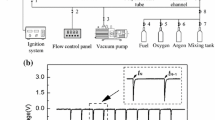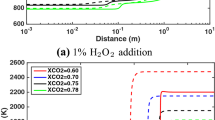Abstract
We present experimental results on the detonability of the H2/NO2 mixture whose detonation exhibits a single cellular structure (λ1) for the lean mixtures and a double cellular structure (fine cells of size λ1 inside larger cells of size λ2) for stoichiometric and rich mixtures. Whatever the equivalence ratio \({\phi}\) , the chemical energy is released in two successive exothermic steps of heat of reaction Q 1 and Q 2 (Q 1 + Q 2 = Q, the total heat release) and characterised (for \({\phi > 1}\)) by two chemical lengths. The detonability is evaluated on the basis of critical conditions of self-sustained detonations transmission from a cylindrical tube of i.d. d to free space. Results show that for the critical tube diameter relationship d/λ1 = k, with respect to the equivalence ratio \({\phi}\) ranging from 0.5 to 1.3 at ambient temperature, k is higher than the classical value 13 and its variation is rather complex. Indeed, d/λ1 increases with \({\phi}\) from 17–18 for \({\phi = 0.5}\) to 45–50 for \({\phi = 1}\) and to 90–100 for \({\phi = 1.3}\) . The highest detonability obtained for \({\phi = 0.6}\) is explained on the basis of the highest relative contribution of the first exothermic step to the total energy Q. We conclude that, as d/λ1 drops with Q 2 decreasing, it should tend to 13 with the vanishing second exothermic reaction.
Similar content being viewed by others
References
Zeldovich, Ya.B., Kogarko, S.M., Simonov, N.H.: An experimental investigation of spherical detonation of gases. Z.E.T.P. 26, 1744–1772 (1956)
Benedick, W.B., Guirao, C.M., Knystautas, R., Lee, J.H.: Critical charge for the direct initiation of detonation in gaseous fuel-air mixtures. AIAA Prog. Astronaut. Aeronaut. 106, 181–202 (1986)
Matsui, H., Lee, J.H.: On the measure of the relative detonation hazards of gaseous fuel–oxygen and air mixtures. In: Proceedings of 17th Symposium (International) on Combustion. The Combustion Institute Pittsburgh, pp.1269–1280 (1979)
Mitrofanov, V.V., Soloukhin, R.I.: On the instantaneous diffraction of detonation. Sov. Phys, Dokl. 159(5), 1003–1006 (1964)
Ciccarelli, G.: Critical tube measurements at elevated initial mixture temperatures. In: Proceedings of 18th ICDERS, Seattle. ISBN 0-9711740-0-8 (2001)
Schultz, E., Shepherd, J.E.: Detonation diffraction through a mixture gradient. EDL Report, Caltech, Galcit (2000)
Moen, I.O., Sulmistras, A., Thomas, G.O., Bjerketvedt, D., Thibault, P.A.: Influence of cellular regularity on the behaviour of gaseous detonations. AIAA Prog. Astronaut. Aeronaut. 106, 220–243 (1986)
Desbordes, D., Guerraud, C., Hamada, L., Presles, H.N.: Failure of the classical dynamic parameters relationships in highly regular cellular detonation systems. AIAA Prog. Astronaut. Aeronaut. 153, 347–359 (1993)
Guilly, V.: Etude de la Diffraction de la Détonation des Mélanges C2H2/O2 Stoechiométriques Dilués par l’Argon. PhD Thesis, University of Poitiers, France (2007)
Sturtzer, M.O., Lamoureux, N., Matignon, C., Desbordes, D., Presles, H.N.: On the origin of the double cellular structure of detonation in gaseous nitromethane. Shock Waves 14, 45–54 (2005)
Joubert, F.: Etude de la détonation de mélanges réactifs gazeux constitués d’un combustible (H2, CH4, C2H6, C2H4) et d’un oxyde d’azote, N2O et NO2/N2O4. PhD Thesis, University of Poitiers, France (2001)
Guilly, V., Khasainov, B., Presles, H.-N., Desbordes, D.: On the effects of argon dilution on detonation diffraction in C2H2/O2 mixture through cones. In: Proceedings of the 21st ICDERS, Poitiers, France (2007)
Author information
Authors and Affiliations
Corresponding author
Additional information
Communicated by L. Bauwens.
Rights and permissions
About this article
Cite this article
Desbordes, D., Joubert, F., Virot, F. et al. The critical tube diameter in a two reaction steps detonation: the H2/NO2 mixture case. Shock Waves 18, 269–276 (2008). https://doi.org/10.1007/s00193-008-0130-5
Received:
Accepted:
Published:
Issue Date:
DOI: https://doi.org/10.1007/s00193-008-0130-5




